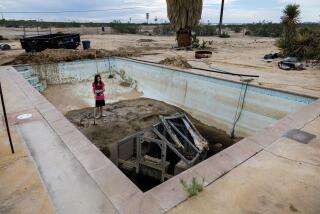Southland’s Latest Disaster: Savage Floods : Weather: Storm drain system is ill-prepared for such a deluge, officials say.
- Share via
Just when everyone expected the hillsides to collapse, the rains ravaged Los Angeles with a different crisis: urban street flooding. Lakes emerged on busy boulevards. Hillside streets became chutes for dangerous white-water rapids. Cars floated away in crazy scenes that seemed more reminiscent of the Gulf Coast than L.A.
The unexpected phenomenon occurred because of the sheer intensity of Wednesday’s storm, which overwhelmed a vast regional flood-control system that is ill-prepared to handle such an onslaught, officials said.
In some communities, as much as two inches of rain fell in an hour. The deluge spread havoc haphazardly among hillside areas and flatland areas, especially in the South Bay, where a number of storm drain pumps simply failed, public works engineers said.
“We had so much water that lids were being blown right off the tops of manholes,” said Richard Garcia, director of street services in Torrance.
Storm drains there and elsewhere became clogged by debris, including discarded Christmas trees left out for trash collectors, public works officials said. Authorities in the city of Carson said municipal cutbacks in drain-cleaning may have contributed slightly to the street flooding.
*
As drains backed up in city after city, homes were damaged, yards were eroded away by instant rivers, and rush-hour commuters found themselves jammed up for hours on streets that became, in many places, all but impassable.
One man--44-year-old Robert Martinez of Signal Hill--died after his car stopped in a flooded intersection in Long Beach, where water was three feet deep, police said. His death was thought to be the result of carbon monoxide poisoning: With water blocking Martinez’s tailpipe, the deadly odorless gas may have seeped into the car’s passenger compartment.
In other rain-drenched places, terrifying human dramas were played out under what seemed the most unlikely circumstances.
A 25-year-old woman from San Pedro nearly drowned in front of her home when rushing water caught her and swept her beneath the front end of her Honda. Edith Duran had just arrived home with her 6-year-old daughter when she tried to wade through the knee-deep torrent on steeply sloped West 18th Street.
Her friend, Don Pursley Jr., who had just driven them home, was part of the frenzied effort to pull her free.
“All we had to do was go 30 feet to her door, but the puddle turned out to be a river,” Pursley said of the current. “You underestimate. You say, ‘It’s not that bad.’ ”
Just before reaching the curb, Duran fell, and at first laughed about it. But as Pursley tried to offer a hand, Duran’s daughter, Marcy Guerrero, slipped from his grasp and was sucked into the torrent. Two neighbors, Manuel Delgado and Steve Maisner, rushed to rescue the child, but then Duran was washed under the car.
All three men tried desperately to pull her out, but they could not get her head above water.
“The water was just gushing in (under her car),” Pursley said. “I was holding on so tight. But her hand was blue and purple. I figured that was it.”
After several minutes, Maisner drove his truck into the back of her car, moving it just enough to enable the men to free her.
“To me, she was dead,” Delgado said. “When we pulled her out, it was like we just knew she wasn’t going to make it.”
*
Rushed to the hospital in critical condition, Duran recuperated enough by Thursday to be listed as stable, although she remained in intensive care. From her bed, she was able to scrawl a note to say that Delgado was wrong.
“I’m alive,” she wrote on a napkin.
In another hillside neighborhood, Victoria Knolls in Torrance, flowing water created a lake at Delos Drive and Ridgeland Road that some residents estimated as 300 feet across. The lake reached the roofs of cars trapped there and rose into the living rooms of several homes, said Linda Dryer, president of the area’s neighborhood association. As the water rushed between houses and continued to flow downhill into a nearby golf course, it dug channels and tore away portions of perhaps half a dozen back yards, she said.
“It’s something we’ve never seen before in all the 33 years that I’ve been here,” Dryer said. “We’ve got it on videotape and it is unbelievable to watch it--the intensity and the amount of water.”
Torrance officials blamed part of the problem on Christmas trees clogging a storm drain at the point where the two streets intersect. But Dryer disagreed, saying she saw the trees afloat in the flood before they eventually were sucked into the drain. At that point, two residents--Tim Hart and Duff Whitman--tied ropes around their waists and dove into the drain in scuba gear to clear away debris.
Whitman, 38, a senior aircraft engineer, had been helping sandbag homes before attempting the risky dive to keep the waters from rising still more. Rain was beating down at the time. He followed Hart down into the drain and tied ropes around the trees, he said. Once the two divers got out, another neighbor pulled the trees out of the drain.
“The biggest concern I had were the electrical wires above,” Whitman said Thursday of his Christmas tree heroics. “The pole on the golf course side was arcing real bad. I was concerned that if we were in chest-high water and if those lines came down, we’d be zapped.”
Residents and business owners in many communities expressed concern over the adequacy of public storm drains built to protect against flood damage. Workers in Smoky Hollow, an industrial section of El Segundo, spent Thursday mopping floors and assessing damage from flooding that filled about a dozen businesses with several feet of water.
It was an all-too-familiar experience for Bob Rinebold, the owner of Bob’s Antique Auto Parts, a Eucalyptus Drive shop that has been flooded several times since he bought the property in 1988.
*
“After this one, we learned to keep stuff about a foot off the ground, “ Rinebold said, pointing to a black line marking the reach of floodwaters that swept through his shop in January, 1993.
The latest storm produced the worst flooding, Rinebold said Thursday as he emptied his shop of the last few inches of water. Soggy papers, magazines and books were stacked on the truck bed of an old Chevrolet El Camino in front of the shop. Wet parts sat on the shelves. Even bills in the cash register were soaked.
“At least the cash is still good,” said Rinebold, who estimated damage at $15,000. This time, he said, the city will pick up the tab for the destruction under the terms of a lawsuit settlement reached because of the continual flooding problems.
The agreement calls for the city to pay for any flood damages Rinebold suffers until the storm drain system is upgraded, he said. If the storm drains have not been improved by next year, he added, the city has agreed to buy his shop.
Although City Manager James W. Morrison said he could not confirm the terms of the lawsuit, El Segundo officials have acknowledged that the drainage system is substandard. The city expects to spend $4.5 million over the next two years to replace electric storm drain pumps with a new system relying on gravity to carry water to the ocean.
In Carson, where severe flooding brought street traffic to a standstill, City Council members recently approved a cost-saving measure to clean out storm drains once a year instead of twice, said Uli Fe’esago,the public works superintendent.
The change saved about $60,000, but about one-quarter of the city’s 700 drains remained uncleaned when the storm hit, Fe’esago estimated. Streets are also being swept clean less often because of a $2-million city deficit, leaving more to wash into the drains, he said.
“When the rain came, a lot of (debris) went into the storm drains,” Fe’esago said. But he and City Engineer George Schultz said that the debris probably had little effect because even major storm channels were overflowing.
“It wouldn’t have mattered,” Schultz said, “because the water simply had nowhere to go.”
All over, water rushed out of the streets and into homes, leaving people nowhere to hide.
*
In Hawaiian Gardens, tenants at Hawaiian Terrace Senior Apartments, a complex for older residents, saw their parking lot become a lake of floating cars. Ground-floor residents were forced to evacuate.
“Somebody came up in the elevator and it had filled up,” said Marie Hubbard, who lives on the second floor. “As soon as the door opened, all of the water came rushing out and ran right into my apartment.”
Parts of Orange County were also hit hard. Floodwaters clogged streets, forced evacuations and tore out a 100-foot stretch of boardwalk in Laguna Beach that may cost $300,000 to repair, city officials said.
Herb Nakasone, county flood control manager, acknowledged that the storm, which dumped nearly four inches of rain in some places in a few hours, was too much for the outmoded flood-control system. Although the bankrupt county has a master plan for improving its drainage channels, there was not enough money--even before the county’s investment debacle--to complete the job.
“It will cost probably over $1 billion to upgrade all of the flood-control system in Orange County to handle these kinds of 100-year storms,” Nakasone said.
But even under the harshest conditions, there were valiant citizens doing their best to cope. One was Max Johnson, a courier, who was racing a deadline Wednesday to deliver a heart valve to Santa Anita Methodist Hospital in Arcadia.
First, the 23-year-old driver got caught in merciless traffic. Then, near the hospital, his truck and about 10 other cars suddenly sank.
“We’re just cruising along and all of a sudden, the ground gave in,” Johnson said.
The heart device was not urgently needed, but Johnson did not know that. He clambered out of the truck, waded through waist-deep water and sprinted the final four blocks to deliver the valve on time. His truck became flooded and later would have to be repaired, but Johnson was elated.
“I knew I’d make it,” he said. “I always make it.”
Times staff writers Carla Rivera, Ted Johnson, Bettina Boxall, Leslie Berkman, Ken Ellingwood and Jean Merl contributed to this story. Times correspondent James Benning also contributed.
CLEANUP BEGINS: As storm waters recede, victims begin cleaning. B1
CONSUMER TIPS: How homeowners and renters can cope with damage. D1.
More to Read
Sign up for Essential California
The most important California stories and recommendations in your inbox every morning.
You may occasionally receive promotional content from the Los Angeles Times.









